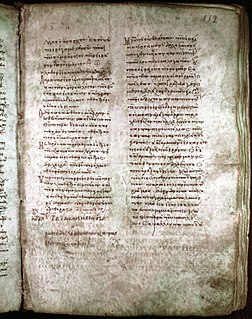Related Research Articles

Codex Laudianus, designated by Ea or 08, α 1001, called Laudianus after the former owner, Archbishop William Laud. It is a diglot Latin — Greek uncial manuscript of the New Testament, palaeographically assigned to the 6th century. The manuscript contains the Acts of the Apostles.
Uncial 051, is a Greek uncial manuscript of the Book of Revelation, dated paleographically to the 10th century.
Uncial 0100, ε 070 (Soden), is a Greek-Coptic diglot uncial manuscript of the New Testament. It is dated palaeographically to the 7th-century.
Uncial 0104, ε 44 (Soden), is a Greek uncial manuscript of the New Testament. It is dated paleographically to the 6th-century.
Uncial 0114, ε 53 ; is a Greek–Coptic diglot uncial manuscript of the New Testament, dated palaeographically to the 8th-century.
Papyrus 31, designated by 31, is an early copy of the New Testament in Greek. It is a papyrus manuscript of the Epistle to the Romans, it contains only Romans 12:3-8. The manuscript paleographically has been assigned to the 7th century. The reverse side is blank. It is possible that it was used as a talisman. Hunt suggested it was a lectionary.
Lectionary 1684, designated by ℓ1684, in the Gregory-Aland numbering, is a Greek manuscript of the New Testament, on parchment leaves, dated paleographically to the 13th century.
Uncial 0204, is a Greek-Coptic diglot uncial manuscript of the New Testament, dated paleographically to the 7th century.

Uncial 0209, is a Greek uncial manuscript of the New Testament, dated palaeographically to the 7th-century.
Uncial 0237, ε 014, is a Greek-Coptic uncial manuscript of the New Testament. Paleographically it has been assigned to the 6th-century.
Uncial 0241, is a Greek uncial manuscript of the New Testament. Paleographically it has been assigned to the 6th century.
Uncial 0242, is a Greek uncial manuscript of the New Testament. Paleographically it has been assigned to the 4th century.
Uncial 0243, is a Greek uncial manuscript of the New Testament. Paleographically it has been assigned to the 10th century.
Uncial 0255, is a Greek uncial manuscript of the New Testament. Palaeographically it has been assigned to the 9th century.
Lectionary 962, is a Greek-Coptic uncial manuscript of the New Testament. Paleographically it has been assigned to the 8th century.
Lectionary 3, designated siglum ℓ3, is a Greek manuscript of the New Testament on vellum. Palaeographically it has been assigned to the 11th century. Scrivener dated to the 10th century.

Lectionary 5, designated by siglum ℓ5. It is a Greek manuscript of the New Testament, on vellum leaves. Palaeographically it has been assigned to the 10th-century.
Lectionary 1599 (Gregory-Aland), designated by siglum ℓ1599 is a Greek manuscript of the New Testament, on parchment. Palaeographically it has been assigned to the 10th or 11th century. The manuscript is lacunose. It is known as Argos Lectionary.
Lectionary 317 (Gregory-Aland), designated by siglum ℓ317 is a Greek manuscript of the New Testament, on parchment. Palaeographically it has been assigned to the 9th century. The manuscript has survived in a fragmentary condition.
Lectionary 316 (Gregory-Aland), designated by siglum ℓ316 is a Greek manuscript of the New Testament, on parchment. Palaeographically it has been assigned to the 8th century. The manuscript has survived in a fragmentary condition.
References
- 1 2 3 4 5 Aland, Kurt; Aland, Barbara (1995). The Text of the New Testament: An Introduction to the Critical Editions and to the Theory and Practice of Modern Textual Criticism . Erroll F. Rhodes (trans.). Grand Rapids: William B. Eerdmans Publishing Company. p. 126. ISBN 978-0-8028-4098-1.
- ↑ NA26, p. 5.
- ↑ NA26, p. 13.
- ↑ NA26, p. 27
- 1 2 "Liste Handschriften". Münster: Institute for New Testament Textual Research. Retrieved 18 December 2015.
- ↑ Kurt Aland (1963). Kurzgefasste Liste der griechieschen Handschriften des Neuen Testaments. Berlin: Walter de Gruyter. p. 10.